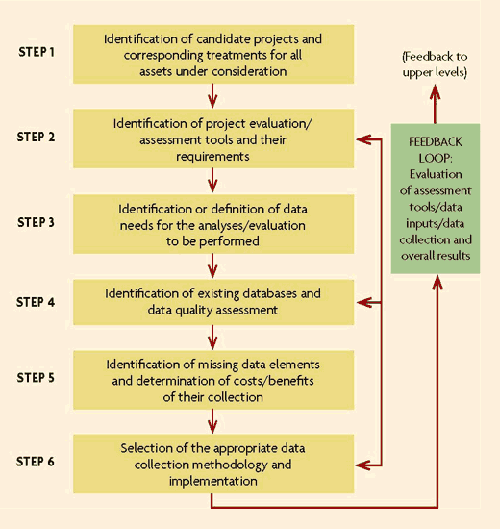Chapter 4. Summary, Conclusions, and Recommendations
The majority of the transportation agencies in the United States and the rest of the world have endorsed the concept of Asset Management. The state-of-the-art has been steadily advancing, and various stakeholders have made significant contributions. However, Asset Management implementation is still at its initial stages, and there are many hurdles to overcome. In this respect, the development of integrated roadway inventories and databases is still underway in many agencies and so is the integration of individual management systems.
Transportation agencies in the United States have explicitly defined decisionmaking levels and are moving forward to a rationalization of their data collection activities. Past agency practices and staff culture is still the predominant decision factor behind data collection, but they have started to give way to decisions based on data collection standards and input needs. In the particular area of project selection, there also seems to be a formally established relationship between the data collected and the decisions supported.
Four States that have identified links between decision processes and data collected were selected to illustrate the process. The resulting case studies showed that there is no one-size-fits-all approach for Asset Management data collection. The most appropriate approach will depend on the agency's needs and culture as well as the availability of economic, technological, and human resources. A gradual implementation of the data collection efforts appears to be the most appropriate approach because it provides opportunities for adapting the processes as data is collected and experience is gained.
A data collection framework for project selection is recommended to optimize the data collection activities for project selection. The process provides clear and logical steps toward the complete rationalization of the data needs for these decisions. This framework, however, can only partially optimize the overall agency data collection activities because it only addresses project selection decisions.
Framework for Effective and Efficient Data Collection
The literature review confirmed that research in the area of Asset Management and its data collection has been extensive. Very little information, however, can be found concerning specified data collection in order to support project selection within the framework of Asset Management. This level links the overall network decisions with the individual projects. Consequently, it requires data that are simultaneously neither too general nor too specific. General data would not help in project selection because they would ignore vital project details, but it is usually not cost effective to collect very detailed (i.e., project-level) data for the project selection process.
Furthermore, project selection has traditionally been made between projects that belong to the same asset class. Asset Management encourages the broadening of this traditional practice by encouraging cross-asset comparisons between the candidate projects for selection. This has obviously increased the data needs and has also created the need for the identification and use of effective selection methodologies that can be applied equally and in an unbiased way to all different asset classes.
The survey of practice suggests that U.S. transportation agencies have clearly identified decisionmaking levels and also have relatively uniform perceptions of the importance of various Asset Management decision processes, project selection criteria, and the corresponding asset data that could support selection between competing projects.
The findings from both the literature review and the survey analysis allowed for the recommendation of the framework for effective and efficient data collection presented in figure 12. In order for an agency to evaluate its data collection needs for project selection, the transportation officials should ask (and reply to) the following questions:
- What are the various types of roadway assets that need work?
- What is the LOS expected for these assets?
- What are the various types of treatments that should be considered?
- What are the evaluation models, techniques, and criteria used by the agency to judge the usefulness of the projects and rank and prioritize them?
- What are the inputs required by these models and techniques for the various projects to be assessed?
- What are the available data?
- What additional data need to be collected?
Once the needed data have been identified, then the agencies can decide on the level of accuracy, precision, and resolution needed and the most appropriate data collection method. The database population and data collection should be as simple as possible without compromising the quality of the decisions. As a final element of the proposed framework, a feedback loop should be established after the missing data have been collected and the analyses performed in order to evaluate the effectiveness of the models and the yielded results and to refine the models, data inputs, databases, and collection methods.
This framework can function as a starting point for transportation agencies that wish to handle project selection in a more systematic way and achieve cost reductions by optimizing their data collection in order to support project selection decisionmaking.
Figure 12. Proposed framework for project selection data collection.  |
However, it is obvious that the use of the proposed framework would only lead to a partial optimization of an agency's data collection activities. This framework addresses only project selection decisions without taking into account the needs of the other levels of decisionmaking that might require overlapping or complementary data and hence require new or extended data collection activities. A similar rationale can be defined for other levels of Asset Management decisionmaking.
For true optimization the data needs of all levels of decisionmaking should be taken into consideration, and a more comprehensive framework for data collection should be established. Further research in the area of project selection data collection should be undertaken to determine the factors that render project selection criteria incapable of handling cross-asset comparisons. Additional effort is also needed to generalize the proposed data collection framework to overall data collection optimization, taking into account all agency decision levels. Complementarily, the identification of champions in the field of data collection to support project selection decisions would allow the derivation of best practices in order to further enhance the proposed framework and eventually develop standards in this area.
This research can help transportation agencies tailor their data collection activities according to their real decisionmaking needs. In this way, it contributes both to the reduction of data collection costs and to a more effective and efficient implementation of Asset Management in its everyday practice. By focusing on the use of the data and the needs of the decision levels and processes to be supported, transportation agencies could define which assets and which data about these assets are most important for decisionmaking, and they could tailor their data collection accordingly.


